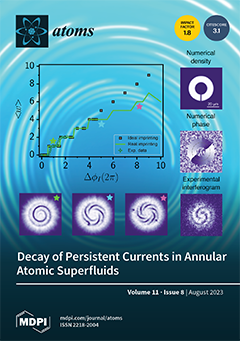We investigate the role of vortices in the decay of persistent current states of annular atomic superfluids by solving numerically the Gross–Pitaevskii equation, and we directly compare our results with the
Li experiment at LENS data. We theoretically model the optical phase-imprinting
[...] Read more.
We investigate the role of vortices in the decay of persistent current states of annular atomic superfluids by solving numerically the Gross–Pitaevskii equation, and we directly compare our results with the
Li experiment at LENS data. We theoretically model the optical phase-imprinting technique employed to experimentally excite finite-circulation states in the Bose–Einstein condensation regime, accounting for imperfections of the optical gradient imprinting profile. By comparing simulations of this realistic protocol to an ideal imprinting, we show that the introduced density excitations arising from imperfect imprinting are mainly responsible for limiting the maximum reachable winding number
in the superfluid ring. We also investigate the effect of a point-like obstacle with variable potential height
on the decay of circulating supercurrents. For a given obstacle height, a critical circulation
exists, such that for an initial circulation
larger than
the supercurrent decays through the emission of vortices, which cross the superflow and thus induce phase slippage. Higher values of the obstacle height
further favor the entrance of vortices, thus leading to lower values of
. Furthermore, the stronger vortex-defect interaction at higher
leads to vortices that propagate closer to the center of the ring condensate. The combination of both these effects leads to an increase in the supercurrent decay rate for increasing
, in agreement with experimental observations.
Full article





